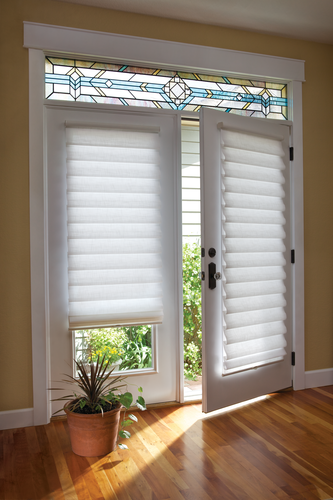Glass doors are a staple of most Minnesota homes, but many homeowners aren’t sure how to decorate them. There are a number of stylish options that let you get the most out of your door without clutter. Houzz offers some design tips for choosing the right covering for your glass door:
1. Drapes: The first option many homeowners consider when dressing French doors is mounting draperies above and beyond the door frame. The effect is a thick fabric border that can be drawn closed at the center or, as in this case, drawn in one direction to cover both the door and adjacent window with two separate panels. To avoid inhibiting the function of the doors, you’ll want to stack those draperies completely on the wall.
Design tip: A good formula for calculating this “stackback,” as it is known in the trade, is to use one-third of your window’s width from frame to frame. If you are using two panels, simply divide this number in half to determine how far beyond the window to mount each one.
2. Shutters: For a clean, tailored look that will blend in rather than shout for attention, you can’t go wrong with custom louvers mounted right on the door frame.
Design tip: Make shutters blend into the room by painting them the same color as the walls.
3. Sliding solar screens: Perhaps no other design option complements a clean, modern sensibility like sliding solar screen panels. Particularly effective at blocking both glare and damaging UV rays, these can be paired with a clear window film to boost protective power even further. They’re an intuitive and incredibly elegant layer for sliding doors, as they mimic the style and function of the door itself.

Photo of Vignette® Modern Roman Shades via Hunter Douglas
4. Roman shades (above the frame): If plenty of wall space exists between the top of the door frame and the ceiling, fill it with a single wide Roman shade treatment that will fold up tightly when not in use but will cover the entire door expanse in one swift motion at nightfall. If you opt for an outside-mounted style like this, keep the design coherent across the room by mounting all the shades at the same level.
Design tip: Taking the fabric at least 2 inches beyond the frame creates a nice visual symmetry and doubly minimizes unwanted light leakage from the sides of the window.
5. Roman shades (within the frame): One of the most common (and functional) ways to use shades to cover door windows is to mount a single shade on each. Whether you go for top-down, bottom-up or for classic Romans, each shade will have its own controls so you can raise and lower them individually.
Design tip: To avoid the inevitable slapping of weighty treatments against the glass when opening and closing the door, use special hold-down brackets, which will keep the treatments in place.
6. Sheer shades: These sheers stack so tightly into the black window frame, they almost disappear. A tropical view in the background demands a window treatment that will do its job controlling glare but that will not obscure the view of swaying palms. While sheers may not be the best selection when privacy is needed, they are great at blocking light while preserving the view.
7. Vertical cellular shades: Another contemporary sliding track option that is equally effective at boosting energy efficiency and being classy, vertical cellular shades provide much the same function and benefits as solar screen panels but with a slightly different look and a bit more texture. Many companies offer up to six layers of insulating cells that block 75 percent of UV rays, rescuing furniture and artwork from premature fading.
8. Exterior shades: We rarely think of mounting our window treatments on the exterior of the home, but under a deep, covered patio like this one, why not? Naturally, this won’t work in every climate, as salt spray, frost and humidity can wreak all kinds of havoc on certain materials, but it’s certainly an out-of-the box option for patio dwellers seeking privacy from those indoors.
9. Stationary panels: The need for privacy and light control is often dependent on the features of a home’s architecture. In this Tuscan-inspired dining room, a private courtyard obviates the need for a truly functional treatment, so stationary panels hung by intricate medallions provide a subtle design element where truly nothing more is needed.
10. Frosted glass: The frosted glass gives a dapper edge to these sliding office doors, complementing the wood tones and tailored look in a way that draperies or bulkier fabric treatments might have compromised. Suitable not only for interiors, frosted glass doors (or opaque window films that give a similar effect) are sometimes seen on the exteriors of more modern-style homes.
11. Shades for Dutch doors: Amid all this talk of French doors and sliders, let’s not forget about charming Dutch doors. Matching shades at the top of the door and the two sidelight windows, as pictured, are the ideal solution here, as each shade can operate independently. You’ll save a bit of money this way too, as the door shade will be half the typical size and therefore require half the fabric.
12. Decorative screens: This extraordinarily innovative screen system is the epitome of an artfully dressed window.
And when you’re ready to install your beautiful new covering, give us a call. Blind Installation and Repair is ready to make any repairs beyond the DIY variety, as well as provide support for installation and adjustments to your blinds. Contact the experts at Blind Installation and Repair. We’d be happy to help!


